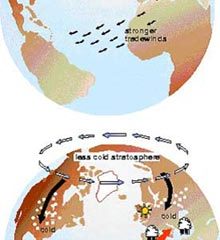Latest News

Scientists discover possible new treatment for genetic diseases
Scientists from Imperial College London, the University of Leicester, and Hammersmith Hospital have found a way to stop certain types of genetic diseases from occurring by modifying the way DNA is turned into proteins.
The research published in this month’s Proceedings of the National Academy of Science shows how the researchers have been able to restore proper expression of defective genes, and that this might potentially have a positive effect in genetic diseases such as spinal muscular a

Crash in male saiga antelope numbers drives species closer to extinction
Scientists researching the population numbers of saiga antelope in Russia have found that in the case of the male, there may be a deadly truth in the old boast, ’So many women, so little time.’
Making use of data gathered from a 10-year field study, scientists report in Nature today that saiga antelope, which rank in the World Conservation Union’s category of most endangered species, are being pushed closer to extinction because there are not enough male antelopes to mate with the fe

The 1991 Mt. Pinatubo Eruption Provides a Natural Test for the Influence of Arctic Circulation onClimate
A recent NASA-funded study has linked the 1991 eruption of the Mount Pinatubo to a strengthening of a climate pattern called the Arctic Oscillation. For two years following the volcanic eruption, the Arctic Oscillation caused winter warming over land areas in the high and middle latitudes of the Northern Hemisphere, despite a cooling effect from volcanic particles that blocked sunlight.
One mission of NASA’s Earth Science Enterprise, which funded this research, is to better understand how th

Major Innovation Push Before the Spring Council
The EU’s innovation information channel CORDIS reveals today the new thinking on innovation policy by the European Commission. Ahead of the Spring European Council (20-21 March 2003), CORDIS is publishing the new Innovation Policy Communication, adopted yesterday by the Commission. The Communication launches a new vision for EU’s innovation policy and gives a new impetus to the drive of making Europe the world’s most competitive and dynamic knowledge-based economy by 2010. It calls for broadening the

European astronomers observe first evaporating planet
Using the Hubble Space Telescope, for the first time, astronomers have observed the atmosphere of an extrasolar planet evaporating off into space. Much of this planet may eventually disappear, leaving only a dense core. The planet is a type of extrasolar planet known as a ’hot Jupiter’. These giant, gaseous planets orbit their stars very closely, drawn to them like moths to a flame.
The scorched planet called HD 209458b orbits ‘only’ 7 million kilometres from its yellow Sun-like st

Southampton scanner provides high level of protection from computer viruses and cyberterrorism
Computer experts at the University of Southampton have just released a new version of their hugely popular free-to-use email security system MailScanner, offering a high level of protection to companies and institutions wanting to safeguard their computer networks from viruses and the potential threat of cyberterrorism.
Developed by Julian Field of the University of Southampton’s world-renowned Department of Electronics and Computer Science, MailScanner processes over 500 million email mes











